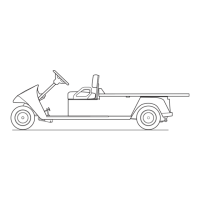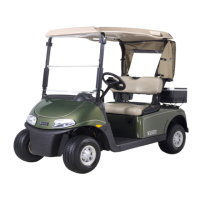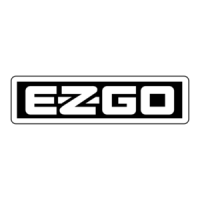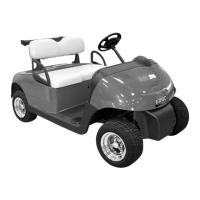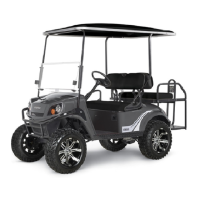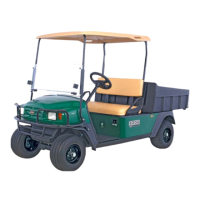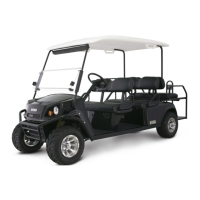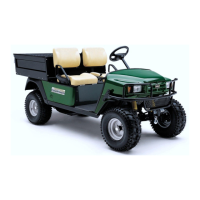Do you have a question about the Ezgo RXV ELECTRIC and is the answer not in the manual?
Explains the use of NOTE, CAUTION, and WARNING symbols.
Details the locations of serial number and date code labels on the vehicle.
Provides instructions and warnings for safely towing the vehicle.
Presents crucial safety warnings for performing vehicle servicing.
Outlines the general guidelines for keeping the vehicle in optimal service.
Specifies the maintenance requirements for the vehicle's rear axle.
Instructions for inspecting tire condition and maintaining correct inflation pressures.
Guidelines for cleaning and caring for the vehicle's body panels and finishes.
Information on the protection offered by the sun top and windshield against elements.
Warnings and instructions to ensure safety when transporting the vehicle.
Information on bolt grades and torque specifications for various fasteners.
Lists fluid capacities and part numbers for common replacement items.
Details the schedule for required maintenance tasks and their intervals.
Emphasizes common sense and adherence to warnings for safe operation.
Guidelines for responsible and safe vehicle operation procedures.
Safety precautions to be taken during vehicle maintenance.
Ventilation requirements during battery charging to prevent hazards.
Critical safety warnings applicable to all vehicle operations and repairs.
Warnings against modifying the vehicle's weight distribution or stability.
Pre-service safety checks and essential warnings to observe.
Further safety warnings related to electrical systems, battery handling, and tool usage.
Procedures and safety precautions for battery removal and installation.
Detailed safety procedures for properly lifting and supporting the vehicle.
General notes on the process of replacing body components.
Step-by-step procedures for replacing various body parts.
Instructions for cleaning and maintaining the vehicle's body and painted surfaces.
Guidelines for repairing paint scratches and body panel damage.
Detailed steps for repairing light scratches on the vehicle's body.
Procedures for addressing minor scratches on the body panels.
Steps for effectively repairing larger scratches on the vehicle body.
Advice on painting or replacing entire body panels for optimal results.
General information and critical warnings for servicing wheels and tires.
Procedures for repairing flat tires, typically using commercial plugs.
Instructions for correctly installing wheels and torquing lug nuts.
An overview of the electronic speed control system's main components.
Procedures for servicing the accelerator pedal assembly and its sensors.
Step-by-step instructions for replacing the vehicle's solenoid.
Procedures for removing, installing, and connecting the electronic speed controller.
Routine maintenance tasks for the front suspension and steering systems.
How tire wear patterns indicate suspension or alignment issues.
Procedures for checking and adjusting the vehicle's wheel alignment.
Steps for removing and installing the front wheel hub assembly.
Procedures for removing and installing the front spindle assembly.
Steps for removing and installing the front suspension struts.
Procedures for removing and installing the front A-arm assembly.
Steps for removing and installing the clipboard and steering wheel.
Procedures for removing and installing the steering column assembly and yoke.
Inspection and replacement procedures for rod ends and ball joints.
Procedures for removing and installing the steering box.
General information regarding serviceable items for the electric motor.
Procedures for removing and installing the electric motor.
Procedures for removing and installing the motor brake assembly.
Essential safety warnings when working on or near vehicle batteries.
Procedures for maintaining batteries at each charging cycle and monthly.
Step-by-step instructions for safely removing and installing batteries.
Guidelines for maintaining battery health during periods of prolonged storage.
Proper procedures and precautions for charging vehicle batteries.
Methods for troubleshooting common battery performance issues.
Explanation of how to use a hydrometer to test battery charge state.
Description of the Powerwise QE 48V automatic battery charger.
Instructions and warnings for installing the portable battery charger.
Explanation of charger operation and LED indicator meanings.
Codes and meanings for charger LED operation and fault indicators.
Maintenance procedures for ensuring the battery charger's longevity.
General information regarding the vehicle's brake system components.
Procedures for servicing the brake pedal assembly and its related sensors.
Information on the routing and components of the main wiring harness.
Step-by-step instructions for replacing the main wiring harness.
Procedures for replacing various electrical components.
Procedure for removing and replacing the vehicle's Run/Tow switch.
Procedure for replacing the reverse warning indicator.
Procedures for replacing common electrical accessories like lights and horns.
Steps for removing and installing the headlight assemblies.
Steps for replacing the headlight bulbs.
Steps for replacing the turn signal bulbs.
Procedure for replacing the headlight switch.
Procedure for replacing the turn signal switch assembly.
Procedure for replacing the turn signal flasher unit.
Steps for replacing the tail light assemblies.
Steps for replacing the tail light lens.
Steps for replacing the tail light bulbs.
Procedure for replacing the horn button switch.
Procedure for replacing the vehicle's horn.
Procedure for replacing the state of charge or fuel gauge.
General overview of the rear suspension components and their connections.
Procedures for removing and installing the rear shock absorbers.
Procedures for removing and installing the rear leaf springs.
Maintenance tasks for the rear axle, including torque checks and lubrication.
Procedure to check the torque required to rotate the axle hub.
Steps for replacing the lubricant in the rear axle.
General precautions and notes before disassembling the rear axle unit.
Procedures for removing and installing the vehicle's rear hub assembly.
Procedures for removing and disassembling axle shafts, bearings, and seals.
Information on the protection offered by the sun top and windshield against weather.
Warnings and precautions to ensure safety when trailering the vehicle.
Procedures for removing and installing the vehicle's windshield.
Procedures for removing and installing the standard golf car top.
Procedures for removing and installing the top for the 2+2 seating configuration.
Guide on connecting and operating the diagnostic unit for troubleshooting.
Overview of the diagnostic unit's menu structure and navigation for accessing data.
Explanation of real-time diagnostic data parameters displayed by the unit.
List and interpretation of error messages generated by the vehicle's system.
List and interpretation of warning messages generated by the vehicle's system.
How to adjust vehicle speed settings and performance profiles using the diagnostic tool.
How to record and view course energy consumption data for analysis.
A detailed table of error codes, their possible causes, diagnostic steps, and actions.
Information on using a DVOM for essential electrical troubleshooting.
Checking the accessory wiring harness for power and continuity issues.
Procedures for checking the vehicle's power supply and battery condition.
Primary functions of building ground systems for safety and equipment protection.
How electronic equipment relates to earth ground and system components.
Requirements for designing and installing lightning protection systems.
Method for providing equipment fault protection ground networks.
Installing conduit and ground conductors according to regulations.
Best practices for earth electrode installation and surveys.
Specifications for ground rod electrodes and conductors.
Components of the earth electrode system.
How the lightning protection system provides a path to ground.
Grounding conductors for AC distribution and DC chargers.
Detailed specifications for the RXV Electric Fleet model.
Detailed specifications for the RXV Electric Freedom model.
Detailed specifications for the RXV Electric Shuttle 2+2 model.
Overall dimensions for the Fleet and Freedom vehicle models.
Overall dimensions for the Shuttle 2+2 vehicle model.
Maximum incline capabilities and turning diameter specifications.
Dimensions and specifications for the Powerwise QE 48V battery charger.
Explains the use of NOTE, CAUTION, and WARNING symbols.
Details the locations of serial number and date code labels on the vehicle.
Provides instructions and warnings for safely towing the vehicle.
Presents crucial safety warnings for performing vehicle servicing.
Outlines the general guidelines for keeping the vehicle in optimal service.
Specifies the maintenance requirements for the vehicle's rear axle.
Instructions for inspecting tire condition and maintaining correct inflation pressures.
Guidelines for cleaning and caring for the vehicle's body panels and finishes.
Information on the protection offered by the sun top and windshield against elements.
Warnings and instructions to ensure safety when transporting the vehicle.
Information on bolt grades and torque specifications for various fasteners.
Lists fluid capacities and part numbers for common replacement items.
Details the schedule for required maintenance tasks and their intervals.
Emphasizes common sense and adherence to warnings for safe operation.
Guidelines for responsible and safe vehicle operation procedures.
Safety precautions to be taken during vehicle maintenance.
Ventilation requirements during battery charging to prevent hazards.
Critical safety warnings applicable to all vehicle operations and repairs.
Warnings against modifying the vehicle's weight distribution or stability.
Pre-service safety checks and essential warnings to observe.
Further safety warnings related to electrical systems, battery handling, and tool usage.
Procedures and safety precautions for battery removal and installation.
Detailed safety procedures for properly lifting and supporting the vehicle.
General notes on the process of replacing body components.
Step-by-step procedures for replacing various body parts.
Instructions for cleaning and maintaining the vehicle's body and painted surfaces.
Guidelines for repairing paint scratches and body panel damage.
Detailed steps for repairing light scratches on the vehicle's body.
Procedures for addressing minor scratches on the body panels.
Steps for effectively repairing larger scratches on the vehicle body.
Advice on painting or replacing entire body panels for optimal results.
General information and critical warnings for servicing wheels and tires.
Procedures for repairing flat tires, typically using commercial plugs.
Instructions for correctly installing wheels and torquing lug nuts.
An overview of the electronic speed control system's main components.
Procedures for servicing the accelerator pedal assembly and its sensors.
Step-by-step instructions for replacing the vehicle's solenoid.
Procedures for removing, installing, and connecting the electronic speed controller.
Routine maintenance tasks for the front suspension and steering systems.
How tire wear patterns indicate suspension or alignment issues.
Procedures for checking and adjusting the vehicle's wheel alignment.
Steps for removing and installing the front wheel hub assembly.
Procedures for removing and installing the front spindle assembly.
Steps for removing and installing the front suspension struts.
Procedures for removing and installing the front A-arm assembly.
Steps for removing and installing the clipboard and steering wheel.
Procedures for removing and installing the steering column assembly and yoke.
Inspection and replacement procedures for rod ends and ball joints.
Procedures for removing and installing the steering box.
General information regarding serviceable items for the electric motor.
Procedures for removing and installing the electric motor.
Procedures for removing and installing the motor brake assembly.
Essential safety warnings when working on or near vehicle batteries.
Procedures for maintaining batteries at each charging cycle and monthly.
Step-by-step instructions for safely removing and installing batteries.
Guidelines for maintaining battery health during periods of prolonged storage.
Proper procedures and precautions for charging vehicle batteries.
Methods for troubleshooting common battery performance issues.
Explanation of how to use a hydrometer to test battery charge state.
Description of the Powerwise QE 48V automatic battery charger.
Instructions and warnings for installing the portable battery charger.
Explanation of charger operation and LED indicator meanings.
Codes and meanings for charger LED operation and fault indicators.
Maintenance procedures for ensuring the battery charger's longevity.
General information regarding the vehicle's brake system components.
Procedures for servicing the brake pedal assembly and its related sensors.
Information on the routing and components of the main wiring harness.
Step-by-step instructions for replacing the main wiring harness.
Procedures for replacing various electrical components.
Procedure for removing and replacing the vehicle's Run/Tow switch.
Procedure for replacing the reverse warning indicator.
Procedures for replacing common electrical accessories like lights and horns.
Steps for removing and installing the headlight assemblies.
Steps for replacing the headlight bulbs.
Steps for replacing the turn signal bulbs.
Procedure for replacing the headlight switch.
Procedure for replacing the turn signal switch assembly.
Procedure for replacing the turn signal flasher unit.
Steps for replacing the tail light assemblies.
Steps for replacing the tail light lens.
Steps for replacing the tail light bulbs.
Procedure for replacing the horn button switch.
Procedure for replacing the vehicle's horn.
Procedure for replacing the state of charge or fuel gauge.
General overview of the rear suspension components and their connections.
Procedures for removing and installing the rear shock absorbers.
Procedures for removing and installing the rear leaf springs.
Maintenance tasks for the rear axle, including torque checks and lubrication.
Procedure to check the torque required to rotate the axle hub.
Steps for replacing the lubricant in the rear axle.
General precautions and notes before disassembling the rear axle unit.
Procedures for removing and installing the vehicle's rear hub assembly.
Procedures for removing and disassembling axle shafts, bearings, and seals.
Information on the protection offered by the sun top and windshield against weather.
Warnings and precautions to ensure safety when trailering the vehicle.
Procedures for removing and installing the vehicle's windshield.
Procedures for removing and installing the standard golf car top.
Procedures for removing and installing the top for the 2+2 seating configuration.
Guide on connecting and operating the diagnostic unit for troubleshooting.
Overview of the diagnostic unit's menu structure and navigation for accessing data.
Explanation of real-time diagnostic data parameters displayed by the unit.
List and interpretation of error messages generated by the vehicle's system.
List and interpretation of warning messages generated by the vehicle's system.
How to adjust vehicle speed settings and performance profiles using the diagnostic tool.
How to record and view course energy consumption data for analysis.
A detailed table of error codes, their possible causes, diagnostic steps, and actions.
Information on using a DVOM for essential electrical troubleshooting.
Checking the accessory wiring harness for power and continuity issues.
Procedures for checking the vehicle's power supply and battery condition.
Primary functions of building ground systems for safety and equipment protection.
How electronic equipment relates to earth ground and system components.
Requirements for designing and installing lightning protection systems.
Method for providing equipment fault protection ground networks.
Installing conduit and ground conductors according to regulations.
Best practices for earth electrode installation and surveys.
Specifications for ground rod electrodes and conductors.
Components of the earth electrode system.
How the lightning protection system provides a path to ground.
Grounding conductors for AC distribution and DC chargers.
Detailed specifications for the RXV Electric Fleet model.
Detailed specifications for the RXV Electric Freedom model.
Detailed specifications for the RXV Electric Shuttle 2+2 model.
Overall dimensions for the Fleet and Freedom vehicle models.
Overall dimensions for the Shuttle 2+2 vehicle model.
Maximum incline capabilities and turning diameter specifications.
Dimensions and specifications for the Powerwise QE 48V battery charger.
| Brand | Ezgo |
|---|---|
| Model | RXV ELECTRIC |
| Category | Utility Vehicle |
| Language | English |
